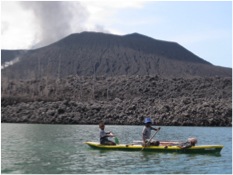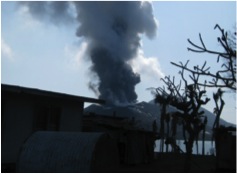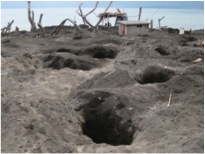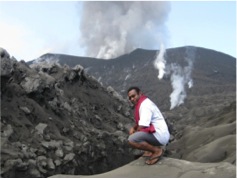by Shangai James Mara
I barely slept the night before we left – in fact, none of us did. We were too excited. As a teaching student it was nothing new to be going on practicum (six weeks of practice teaching), but for us this was different. We weren’t heading to any regular local school. We were heading to East New Britain Province in the South Pacific. A trip that seemed to us to be 90% adventure, 10% suicide mission.
We were heading to Matupit Island, a small island of only three thousand people that is home to Mount Tavurvur, a live volcano considered one of the most dangerous in the world. It last blew its top in 1994. The devastation affected the livelihood of the people on the Island in terms of food, water and shelter. On my arrival, I asked an elderly man standing next to me, “Why don’t these people just leave the Island and move to the mainland?”
“Oh son,” he said, “This is our home. Generation after generation have lived with Tavurvur, but Tavurvur has never taken any lives. Tavurvur is part of us; it destroys and provides at the same time.”
It wasn’t quite enough of an answer for me. “How are you surviving right now when the sources of food from the land and sea were completely destroyed? And even the smell… its so weird?”
“Son,” he said, “God has given every man a place to live and prosper and this is where he placed us; despite the smell and the dust we are here to stay…God bless Matupit Island.”
There isn’t much you can say to that level of acceptance and faith.
Seen from the above, the island seems naked, covered with smoke, dirt and dust from the volcano. The dust is mixed with the sand and the smell of sulphuric acid. As long as the volcano is still active, the smell never changes and constantly produces thick smoke with heavy dust. The dust causes corrosion to any metal it comes in contact with, because the dust is mixed with salt from the ocean. It’s not an easy to place to visit, so it must be incredibly difficult to live here.
That evening for the first time I witness natural  fireworks. The shooting of red-hot stones out from the volcano creates a brilliant sparkling of light in the clear night sky. It creates a symphony of different sounds before releasing this flaming rock into the air. It is not, unsurprisingly, a very soothing sound and it kept me awake all night. The volcano was about a mile away from where I was staying but the roar fills the quiet night and like a Boeing 747 touching down on the roof. The small house literally shakes all night. At every moment if feels as though it will fall or be swept away by the noise, or the flames. Not a good night’s sleep.
fireworks. The shooting of red-hot stones out from the volcano creates a brilliant sparkling of light in the clear night sky. It creates a symphony of different sounds before releasing this flaming rock into the air. It is not, unsurprisingly, a very soothing sound and it kept me awake all night. The volcano was about a mile away from where I was staying but the roar fills the quiet night and like a Boeing 747 touching down on the roof. The small house literally shakes all night. At every moment if feels as though it will fall or be swept away by the noise, or the flames. Not a good night’s sleep.
The lava from the volcano flows down the side of the volcanic mountain into the ocean and solidifies when it gets cold. The next morning I climb the mountain. I can feel the stone beneath my feet becoming hotter the higher I get. It would be impossible to walk bare foot on the hardened lava anyway because it’s excruciatingly sharp after being solidified. It may be harsh, but it is beautiful. Exquisitely so, because I have never seen anything like it. The grey of the lava, the yellow sulphur and the golden sand and work together to create a landscape of unusual beauty.
Although the volcano destroyed vegetation and all forms of food supply, it compensated with an “A” grade fertile soil for the new plants to grow very well. The dust is incredibly rich in minerals; in fact it is so fertile that food crops grow to three times the normal size. This is part of the reason people worldwide still live near active volcanos. (Pompeii anyone?) Running my fingers through this rich soil reminds me of what the elderly man said about the volcano providing for them.
The heat from the volcano does something else for Matupit. It provides a warm environment conducive for the fowls to lay their eggs on the island. Interestingly, fowls lay their eggs about 1-2 metres inside the warm sand. The eggs are as big as the size a twelve year-old-child’s fist. Though it’s dangerous, the village men manage during the safe hours when the lava is not flowing, to dig and collect the fowl eggs for food and sell them at the market for cash.
The government and the Natural Disaster Authorities find it very difficult to persuade the people to leave Matupit Island. It’s their home and, to use an old cliché that really fits this harsh place, home is where the heart is. I spent a memorable couple of weeks teaching at the tiny school here and returned from my practicum with some truly unique memories.
The most important lessons I learned? You live  where you love to live – no matter how harsh it may be. And there is no place on earth that is not worthy of a visit. Wild, volcanic islands included.
where you love to live – no matter how harsh it may be. And there is no place on earth that is not worthy of a visit. Wild, volcanic islands included.
Author’s Bio: Shangai James Mara is a student at Avondale College and loves to travel. He is from Enga Province, Papua New Guinea and is passionate about sharing interesting moments that have made an impression on him. He lives in Newcastle, Australia and loves to write by the light of the sunrise.

